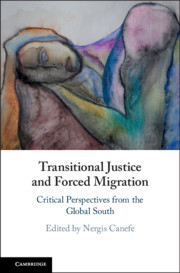Book contents
- Transitional Justice and Forced Migration
- Transitional Justice and Forced Migration
- Copyright page
- Dedication
- Contents
- Contributors
- Preface
- Acknowledgements
- Abbreviations
- In Lieu of an Introduction
- Part I The Past as the Memory of the Future
- Part II Law, Justice, and Hope
- Part III Ethics of Witnessing
- Index
- References
Part III - Ethics of Witnessing
Published online by Cambridge University Press: 24 October 2019
- Transitional Justice and Forced Migration
- Transitional Justice and Forced Migration
- Copyright page
- Dedication
- Contents
- Contributors
- Preface
- Acknowledgements
- Abbreviations
- In Lieu of an Introduction
- Part I The Past as the Memory of the Future
- Part II Law, Justice, and Hope
- Part III Ethics of Witnessing
- Index
- References
Summary

- Type
- Chapter
- Information
- Transitional Justice and Forced MigrationCritical Perspectives from the Global South, pp. 191 - 293Publisher: Cambridge University PressPrint publication year: 2019

